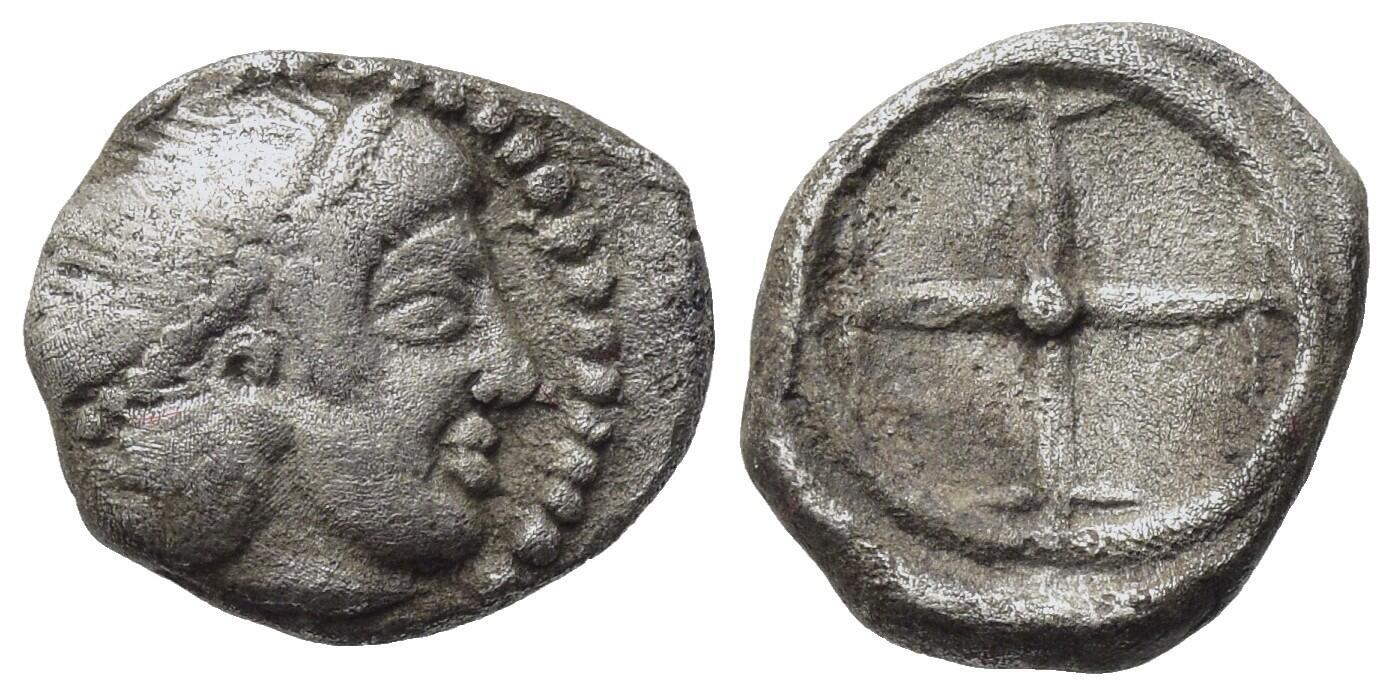AC 92 - Syracuse, silver, obols (478-466 BCE)
From SILVER
478 BCE - 466 BCE Silver 901 kg
Description
| ObverseInscription or printing placed on the obverse.: | Diademed head of Arethusa r. |
| ReverseInscription or printing placed on the reverse.: | Wheel of four spokes |
Mint and issuing power
| MintIdentifies the place of manufacture or issue of a numismatic object.: | Syracuse | Ancient regionAncient region.: | Sicily | Modern countryModern country: Italy | AuthorityIdentifies the issuing power. The authority can be "pretended" when the name or the portrait of X is on the coin but he/she was not the issuing power. It can also be "uncertain" when there is no mention of X on the coin but he/she was the issuing power according to the historical sources: | Hieron I of Syracuse |
Chronology
| FromIdentifies the initial date in a range assigned in a numismatic context. | 478 BCE | toIdentifies the final date in a range assigned in a numismatic context.. | 466 BCE | PeriodTime period of the numismatic object.: Archaic and Classical |
Physical description
| MetalThe physical material (usually metal) from which an object is made.: | Silver |
Median weightMedian of the weights of numismatic objects (in grams). in grams | 0.65 | DenominationTerm indicating the value of a numismatic object. Examples: tetradrachm, chalkous, denarius.: | obol |
StandardStandard.: | Attic |
Image

AC 92 - Syracuse, silver, obols (485-479 BCE).jpg [1]
References
| Die study referencePublication of the study: | Boehringer 19291Boehringer 1929, p. 167, n° 286-291, p. 182-183, n° 362-370 et p. 188-190, n° 392-407. | ||
| Coin series referenceReference to coin series study: | Sear I2Sear I, n° 917 and 922, RQEMAC3RQEMAC, n° 92, HGC 24HGC 2, n° 1371 | ||
Obverse dies distribution
| FrequencyFrequency of specimen in distribution. ᵖ | Number of obversesNumber of obverse dies. ᵖ (o) | % (o) | Number of coinsNumber of coins. (n) | % (n) | Die nameName(s) of the die(s). |
| 1 | 13 | 86.67 | 13 | 72.22 | 133, 134, 135, 138, 179, 180, 181, 182, 183, 184, 185, 186, 187 |
| 2 | 1 | 6.67 | 2 | 11.11 | 137 |
| 3 | 1 | 6.67 | 3 | 16.67 | 136 |
| Total | 15 of 15 | 100.01 | 18 of 18 | 100 |
Reverse dies distribution
no distribution is available
Quantification
| Number of obversesNumber of obverse dies. ᵖ (o) | 15 | Number of singletons (o1)The number of singleton coins. ᵖ | 13 |
| Number of reverse diesNumber of reverse dies. (r) | 15 | Number of coinsNumber of coins. (n) | 18 |
| Coins per obverse dieNumber of coins per obverse die. (n/o) | 1.2 | Coins per reverse dieNumber of coins per reverse die. (n/r) | 1.2 |
| Reverse per obverse ratioRatio of obverse dies divided by reverse dies. (r/o) | 1 | Percentage of singletons (o1)number of coins (n) divided by the number of singletons (o1) ᵖ | 86.67 % |
| Original number of dies (O) (Carter 1983 formula)The estimation of the number of coins according to Carter 1983 ᵖ | 69.28 | Coins struck if 20,000 as average productivity per dieCoins made if the average productivity for obverses (according to Carter) is 20,000. ᵖ | 1,385,600 |
| Original number of dies (O) (Esty 2011 formula)The estimation of the number of coins according to the singleton formula in Esty 2011 ᵖ (O) | 90 | Survival rate if 20,000 as average productivity per dieSurvival rate if average productivity is 20,000. ᵖ | 0.00001 |
| Coverage (o = % of O) (Esty 1984 formula)Esty 1984 - coverage (% of O) ᵖ (o = % of O) | 27.78% | Die productivity if survival rate 1/2,000Average productivity if survival rate is 1/2,000. ᵖ | 519.63 |
| Weight of silver (in kg) if 20,000 coins per die (O = Carter formula)Carter 1983 * Median weight * 20000 (*10 if gold or electrum) ᵖ | 901 kg <br /> 901 kg | Die productivity if survival rate 1/5,000Average productivity if survival rate is 1/5,000. ᵖ | 1,299.08 |
Remarks